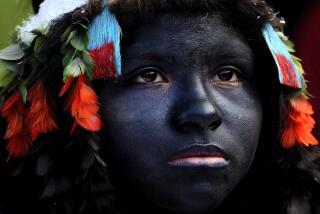Prehistoric Jungle Fertilization a Puzzle
- Share via
NOVA ARIPUANA, Brazil — The search for monkey species in the Amazon led scientists to an intriguing heritage of prehistoric Indians: the terras pretas, or black earth.
The terras pretas are extremely fertile patches of rich, dark soil, rarely more than a few acres but 7 feet to 17 feet deep, that dot the otherwise poor soil along the Aripuana River. Scientists believe they were fertilized by ancient tribes as long as 10,000 years ago.
No one knows just what the Indians did. But the amazing richness of the soil persists today, which is why most villages along the Aripuana are built on terras pretas.
“If we could figure out how they did it, and if they did it over a relatively short period of time, it could be the solution to the Amazon’s problems,” said Wim Sombroek, a Dutch soil specialist with the Group of Seven’s Pilot Project for the Amazon.
The manicore marmoset, recently discovered by Dutch primatologist Marc van Roosmalen, also tends to inhabit the terras pretas. It has adapted to the trees and fruits, which were introduced and first cultivated by the Indians.
Roosmalen plans to use carbon dating to determine how long ago the terras pretas were fertilized. He hopes that an analysis of the pollen in the soil will provide a clue as to how the Indians fertilized it.
Farmers working the terras pretas occasionally uncover ancient bread that Indians made from manioc, a potatolike tuber, and buried thousands of years ago.
Scientists say the Indians worked one area for a few years and then moved on. Before leaving, they buried the bread to tide them over when they returned and waited for the harvest to ripen.
“Sometimes you can still eat them,” said Secundo dos Santos Ramos, a farmer who moved here 20 years ago.
Roosmalen, who has tasted the ancient bread, describes it with a single word: dry.
More to Read
Sign up for Essential California
The most important California stories and recommendations in your inbox every morning.
You may occasionally receive promotional content from the Los Angeles Times.













